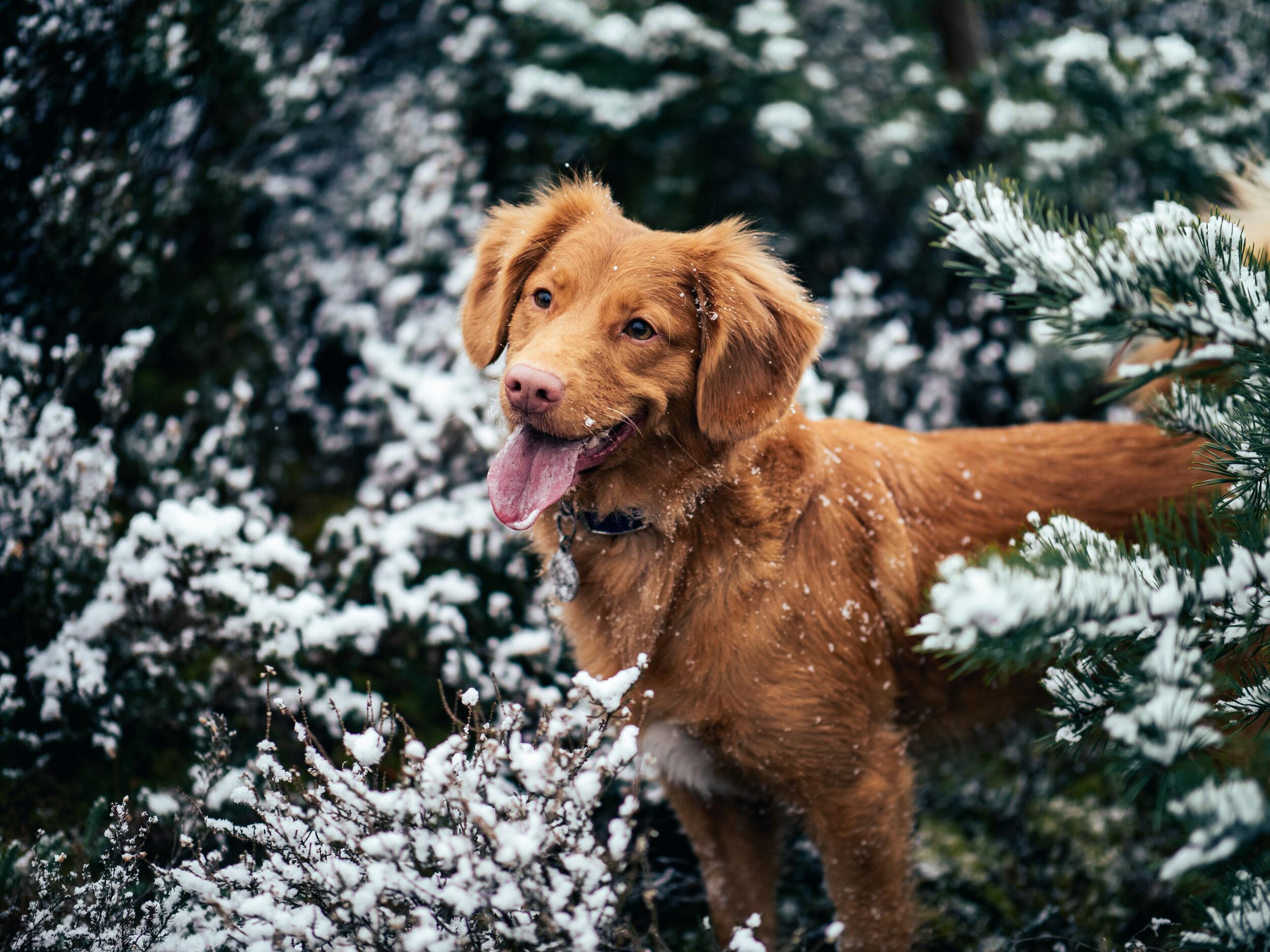Is My Dog too Cold?

Photo by Jamie Street on Unsplash
Some dogs love rolling in the snow, while others are happy to sit out the cold weather in the comfort of a centrally heated house. For the snow-lovers, thick fur is definitely an asset. Breeds such as Siberian Huskies and Alaskan Malamutes, bred for life and hard work in cold climates, will have no problems at all with the average Winter temperatures.
Hardy breeds with thick coats, such as German shepherds, Poodles and Golden retrievers, will love their cold weather walks, too. Thin coated breeds such as Greyhounds and Whippets, and small dogs such as Chihuahuas and Yorkies need to be protected from the cold. Puppies, older dogs, and ill dogs may need extra care in the Winter, too.
Whatever the breed, never leave it outside in very cold weather, as even a hardy dog can succumb to the chill if its body temperature gets too low.
How do you know if it’s too cold for your dog?
You will soon be able to tell if your dog is feeling the cold, as it will simply tell you! Dogs will be reluctant to go on a walk or will not be as active as usual during the walk, sitting down in a sheltered spot or walking much more slowly than usual. Cold dogs may become anxious, whining and walking by your side, looking at you pleadingly. Smaller dogs will begin to shiver very quickly in the cold, and even larger breeds may shiver after a while. If there is snow underfoot, a dog may limp if it feels uncomfortable with the ice in its toes.
It will not often come to this, though – certainly not in healthy dogs. They will do so much running that they will not feel the cold unless the snow itself becomes a problem in their fur or between their toes.
How cold is too cold for a dog?
Generally, 45°F is a minimum temperature, at or above which all dogs will be comfortable. As the temperature dips towards 32°F, less hardy dogs will need to wear a dog sweater or coat. In extreme cold, all breeds other than those super-hardy Huskies, Malamutes, Samoyeds and Newfoundlands are in danger of becoming too cold.
How do you know if your dog needs a coat?
The question of whether it is too cold for your dog is largely down to breed and is also influenced by the age and health of your pet.
Dogs with fine hair and/or thin body types (e.g. Greyhounds) will need to wear a coat outside when the temperature dips. If there is snow on the ground, small dogs and puppies will need a coat during walks or playtime in the park. Being small, they become cold quicker than larger dogs, and their undersides get cold quickly too, simply because their bellies are closer to the ground.
Older dogs and young puppies have relatively weak immune systems and can become ill if they get too cold. Old dogs with arthritis suffer in cold weather, too, and may even require a coat indoors during the winter to ease their sore joints.
Lighter-furred dogs may benefit from a dark coat to soak up a bit of Winter sun heat. If the wind is strong and icy, a coat can make things much more comfortable for any breed (with the exception of the dogs bred for harsh conditions).
Even a hardy dog can become very uncomfortable in the snow, as their fur may accumulate the frozen stuff. Dogs will instinctively try to clear their snowed-up muzzles and heads by rubbing them on the ground – thus gathering even more snow! A dog’s toes can get iced up to, which is clearly uncomfortable for them.
The snow can be removed periodically during the walk (although it will sometimes form ice and cannot be immediately removed). A good thaw-out back home will cure the problem, though.
How to keep your dog warm throughout the Winter
Knowing your own dog’s needs is key to knowing if the dog is too cold. Dogs do not need to be cozy/warm at all times, and you may have noticed how they will sometimes seek out a cool part of the floor to lie down on, especially when the central heating is switched on in the Winter. It is a fact that overheating is, in general, more of an issue than feeling the cold.
Dark-furred breeds benefit from Winter sun, being able to absorb what little heat there might be in the sun. Lighter colors reflect the light, and the heat too.
If your dog needs a coat in the cold, that’s a simple remedy against the Winter chills. A cozy bed is important, too, to keep your dog warm at night.
Avoiding severe doggie haircuts in the Winter is a good idea, as a drastic trim is not going to help in the battle against the cold!
How do I know if my dog is too cold at night?
As long as your dog has a soft bed to lie on, and as long as the room temperature remains above freezing, dogs are unlikely to get too cold. The dog will curl up and snuggle down, its own body heat sufficient for a good night’s sleep.
Making sure you have a dog bed that’s fit for every season is important. It doesn’t get much better for dog when they have a cozy bed to relax in after a long Winter Day. A bed that can be raised off the ground, to improve ventilation and prevent the bed from becoming too hot on a warm floor or too cold on a chilly one will benefit your dog .
.
A high-quality dog blanket can help, too – especially if your dog has a kennel or crate outside. Your dog will snuggle under it, or push it aside, just as you might do with a quilt, helping to keep the perfect temperature throughout the night.
Note: only very hardy breeds can cope with an outdoor crate or kennel in the Winter, even if it is fully weatherproofed.
What happens if dogs get too cold?
The main signs that your dog is too cold are shivering and whimpering. A dog who is shivering should be wrapped in a blanket and taken somewhere warm as soon as possible. That will usually do the trick.
If a frail or small dog is too cold, it can become ill. The cold lowers their immunity, giving diseases the chance to gain a foothold. If, during cold weather, your dog is constantly sneezing or has discharge from the eyes and/or nose, it could be a sign of dog cold or dog flu, canine influenza or other illnesses.
Dogs with hypothermia
Although highly unusual, it is possible for a dog to suffer hypothermia. This is when its body temperature has fallen from the normal range of around 101°F to 102.5°F to (99°F) or lower. Such a plummet in temperature can prove fatal, even if you manage to get your dog quickly back to a warm spot.
You can tell if your dog has hypothermia, or is in danger of succumbing, by watching how it behaves. The symptoms include lethargy or sleepiness, clumsy movements, stiff limbs or breathing difficulties.
Prevention is the only remedy here. Know your dog, know their physical limitations, and use your judgement to prevent putting the dog in an environment that might mean your dog is too cold and could thus lead to hypothermia.
Dogs with frost bite
Frostbite is another cold weather risk. In extreme cold, a warm-blooded animal’s body protects its vital organs, redirecting blood flow there. This means that extremities such as ears, noses, tails and paws are at risk of freezing. If any of those parts of the body is bright red or black, your dog could be suffering from frostbite and should be warmed up immediately.
If your dog’s ears or tail feel ‘like ice’ when you hold them, it’s probably time to cut the walk short and head indoors.
In general, if you feel cold outside, in spite of your coat, hat and gloves, your dog will be feeling the cold pinch too. Common sense plays a big part when trying to tell if your dog is too cold in the Winter, and an animal as intelligent as a dog will certainly let you know if the cold weather is making it feel uncomfortable.
This entry was posted in Dogs